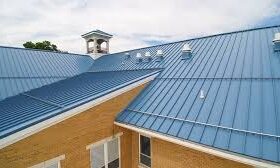Your roof is your home’s barrier against the elements, protecting everything inside. So it must be in good condition to prevent water damage and other issues impacting your family’s health and safety.
Look for stains on the ceiling, curling or buckling shingles, and other signs that your roof is nearing its end. Here are seven of the most significant signs it’s time to replace your roof:
Water Stains
A roof should last for 20 years, so if you notice signs of aging, like water stains or discoloration, it may be time to replace your roof. If you notice a damp smell, that could be another sign of moisture damage to your roof and should be looked into as soon as possible.
Water stains are not only unsightly, they can lead to structural damage to your home. Structural damage makes repairing and replacing your roof much more expensive, so it’s essential to act on any warning signs as soon as possible.
Flashing is designed to seal around chimneys and other roof fixtures, but the flashing needs to be fixed if you notice holes or rust. A quick and inexpensive solution is to add more sealant or replace the old rusted flashing.
Dark Streaks or Discoloration
Shingle roofs’ dark spots and streaks can be unsightly and are often mistaken for soot, dirt, mildew, or mold. However, the ugly black streaks are most likely caused by a hardy type of algae called Gloeocapsa magma. This type of algae likes to grow on shaded, damp areas and forms a dark outer coating that stains asphalt shingles. It feeds on the limestone in shingles and can cause them to become brittle and prematurely age.
This problem can be improved by cleaning the algae off your roof with a chlorine bleach and water solution or hiring experts to do the job from the best roofing company in New Jersey. Avoid using a high-pressure washer, which can damage the integrity of your shingles. Instead, cover plants and bushes you don’t want to bleach with plastic tarps before spraying your roof with the cleaning mixture.
Missing Shingles
It’s always essential to replace a missing shingle immediately. While one shingle might not cause a leak immediately, it can lead to a slow drip that eventually damages your home’s sheetrock, drywall, wood trim, and paint.
It can also signify a hole in your roof where water, sun, and wind enter your home. A professional can help determine if this is the case.
You should also be aware if you’re seeing a lot of shingles in your yard or gutters. These are possible signs that your roof is reaching the end of its life and should be replaced. The granules on your shingles are vital for their weatherproofing properties, and when they start to fall off, it’s time to consider a replacement.
Cracked Shingles
Seeing shingle cracking is one of the most obvious signs it’s time for a new roof. These cracks, also known as crazing, result from excessive sun damage and can lead to leaks if left unchecked.
These cracks differ from thermal splitting, caused by the contraction and expansion of shingles due to the weather and temperature. While both pose the same risks, it’s better to catch these problems early so you can replace only the affected shingles.
Loose shingle granules on your lawn or in gutters are another sign it’s time for a roof replacement. These granules help protect and insulate your home, so any excess loss means it’s time to start planning for a new roof. A roofing contractor can help you find a color that matches the original shingles so your new roof looks seamless.
Water Leaks
If your roof leaks, water will enter your home and ruin fabric coverings, causing wood framing to rot and mold or mildew. This can be a significant health concern for you and your family, and it will also decrease the value of your home and lead to costly repair bills.
Dark spots on your ceiling are another sign of a leaky roof. These are caused by a loose or damaged step flashing, which is the area where the roof meets the walls. The flashing is installed in the valleys of your roof and around anything that penetrates your roof, such as chimneys.
A leaking roof can also cause moisture to seep into your attic insulation, clumping up and losing functionality, increasing energy bills.
Damaged Flashing
Flashing is a metal layer covering vulnerable areas on your roof, such as chimneys, skylights, and corners. The roof may leak when it erodes or becomes damaged, leading to water spots and mold on your home’s walls, ceilings, or other surfaces.
The most common sign of flashing damage is a musty smell that worsens after it rains. If you notice this, it’s time to call a roofing contractor for an inspection as soon as possible. Other signs of lousy flashing include discoloration around the areas where building contractors install them, leaking near windows, and gaps in the area. Flashing prevents leaks by blocking cracks and crevices, allowing them to expand and contract with temperature changes, and redirecting water away from the roof structure.
Stains or Discoloration
Your roof is an essential investment in your home. It keeps the elements out and protects the structure of your house from water damage, but if it starts to deteriorate or lose its integrity, you will need to replace it.
You can check the condition of your roof by inspecting it from the ground and inside your attic. Look for discoloration, dark streaks, and moss or mold growth.
Streaks and discoloration are a sign that it’s time to replace your roof, but replacing the entire roof may not be necessary. You can repair some problem areas and get more years out of your roof. Inspect it professionally before you start spending money on a total replacement.












